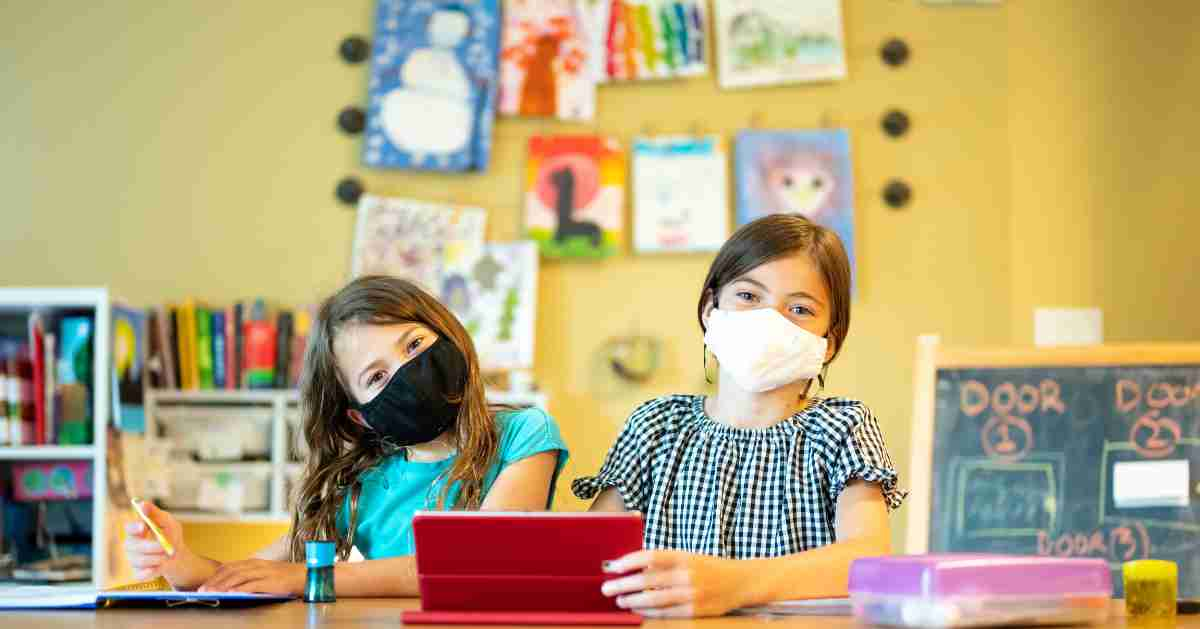How to Help Keep Students Safe from Covid-19

With the first pandemic in over 100 years holding the world hostage in its crushing grip, the fate of America’s school systems hangs in the balance. Distance learning is a good option for some, but it doesn’t work for every student, especially those within the lower-income bracket. According to the US Census Bureau, only 65.8% of lower-income households (below $50,000 a year) reported using the internet for schoolwork. That’s barely over half! Sadly, more and more kids are slipping through the cracks, and by enforcing safety guidelines in schools, every student can get the attention and care they need to learn, grow, and succeed.
While mobile learning was a relatively effective and quick fix, it’s not ideal for every student. Some students need the discipline of a daily school routine, and for some, a mix of in-person and virtual learning is the best method. Going back to in-person learning was always inevitable, though, and kids were back in school in the fall of 2020. It can be incredibly challenging for educators and the administration when it comes to helping keep kids safe at school from COVID-19, and the younger the student, the more difficult it becomes. However, there are effective ways to lower the risk of transmission for every student in school, and by enforcing new rules and guidelines, kids will have a safer environment in which to learn and grow.
How to Provide Safe Learning for Students and Teachers
Bringing kids back into school means that the entire school infrastructure needs to be radically changed. Rules and guidelines must be overhauled, and any changes made must be in accordance with new legislation passed concerning Covid-19. Younger children will need even more help and guidance than older students and will have to be closely monitored and encouraged to ensure all the rules are correctly followed. With the high fatality rate of those with Covid-19, making the right changes to ensure safety in schools is critical towards keeping future generations safe and healthy.

Avoid Mixing Different Groups of Students
One of the best learning methods right now is giving students the option to choose a combination of virtual and in-person learning. When students are physically inside the school, they should be separated into different groups, which should not be allowed to mix. When you restrict socializing between groups, you prevent germs from being passed back and forth between students and staff.
It’s ideal to split the students into the smallest groups possible. That way, if there is an instance where somebody gets sick, it will not only be easier to track the source, but it will only be a small group at risk for exposure, rather than the entire school.
Modify Classrooms for Social Distancing
Re-configuring each classroom is necessary and helps lower the risk of virus exposure for students and teachers. The number of desks must be reduced to allow for six feet of space between each one. If that’s not possible, install Plexiglas dividers between each desk for extra protection. An effective way to encourage both younger and older students to stay six feet apart is by placing stickers on the floor showing where it’s safe to stand. Signs should be placed school-wide, reminding students to wash their hands or use an alcohol-based sanitizer regularly.
Upgrade the Ventilation Systems
An ideal way to help reduce transmission of the virus is by modifying and upgrading the school’s current ventilation or HVAC system. Sure, opening doors and windows allows for some increased air circulation, but it doesn’t compare in the least to installing a brand new air duct system. Better airflow and circulation keep the air in classrooms from getting stale. Also, having better air quality benefits any high-risk students with existing health problems, such as asthma or breathing issues.
Limit Extracurriculars
It’s a sad fact that COVID-19 has prevented the occurrence of many extracurricular activities and sports teams, but unfortunately, it’s become a necessary evil. The very nature of playing sports makes it the perfect delivery system for a virus-like COVID-19. Though it may be disappointing for students and their parents, especially those in their senior year, limiting extracurriculars isn’t a way to punish; it’s a way to keep students safe.
Implement Guidelines for Foot Traffic
Another effective way to keep students at a safe distance from each other in school is to make the hallways one-way for foot traffic. Students, in particular teenagers, tend to crowd the halls in-between classes and loiter by their lockers with their friends. By enforcing foot traffic guidelines, it will keep students heading in the same direction and six feet apart.
Mandatory Face Coverings and Hand Washing
One of the most controversial topics in America right now is whether it should be mandatory to wear a face mask. The answer is yes! Face coverings should be worn by every student, teacher, and visitor to the school. It has been proven repeatedly that wearing a face mask dramatically reduces the chances of catching Coronavirus. Politely ask any visitors to show official paperwork if they have a medical exception and can’t wear a mask.
Mandatory hand washing will also significantly reduce the risk of transmission. The CDC recommends placing hand sanitizing stations at every entrance and exit to encourage exemplary hygienic practices. Place plenty of signs showing how to effectively and correctly wash hands. Younger kids, in particular, will need some extra encouragement when it comes to proper, regular hand washing and keeping a face mask on all day. It’s every parent’s nightmare for their young child to come home from school wearing a different mask because they traded with their friend at school!
Effective Communication
Having a convenient and quick communication system is essential. It allows for virtually the whole school to receive critical information simultaneously within a short time frame. You can send texts or emails about the new guidelines and rules for when students come back into school, so they have up-to-date information and time to prepare. Another great way to effectively distribute information is by announcing the new rules every day over the P.A. system to keep it fresh in the minds of both students and staff.
Flexible Class Times
Having a flexible course schedule is a requirement for helping keep students safe from Coronavirus. Schools with an extensive roster of students will benefit from having different, flexible class times for separate groups. Some kids can go to classes in the morning and others in the afternoon. It could also be separated by days, with some going Monday, Wednesday, Friday, and others on Tuesday, Thursday, and Saturday. The options are endless, and it helps keep kids safely isolated from each other. Students might not be thrilled about going to school on a Saturday, but dealing with Covid-19 requires a unique ability to change along with the times and learning to adapt to a new way of life successfully.
Hold Classes Outside Whenever Possible
Having students learn outside when the weather allows has a few different advantages. For starters, being out in the fresh air promotes learning and helps students stay more engaged. The better air circulation also helps keep transmission rates down, much more effectively than being inside a classroom, even one set up for social distancing. Students also love having class outside and can be easily encouraged to move outdoors, especially on a warm and sunny day. Lunch can also be outside, and with a wide-open space, it’s even easier to practice social distancing.
Limit Visitors
Restricting the number of visitors that come into the school is another effective way to lower transmission rates. Only allow essential care workers or aides to go inside and make every visitor sign a guest book with their name, address, and phone number. With contact information for every guest, if there is an outbreak, anybody who was potentially exposed can be notified quickly.
Set Protocol for Pickups and Drop-Offs
The beginning and end of the school day can be hectic, confusing, and inevitably brings crowds of students all trying to leave at the same time. By staggering pickup and drop-off times for each specific group, there will be better traffic flow and less crowding, lowering the risk of infection.
Clean, Sanitize, and Disinfect
Though it may seem obvious, the number one way to keep kids safe from Covid-19 is to disinfect any public surfaces multiple times during the school day. Door handles, bathrooms, desks, chairs, everything in the school that could potentially be touched by a student or staff should be sanitized regularly. The best way to do this is with alcohol-based cleaners, and as stated before, by placing plenty of hand sanitizing stations all around the school.
Check Temperatures Every Morning
Set up stations right inside the school’s doors for students to have their temperature checked every morning. Get a hand-held reader that will accurately tell temperature when held close to the forehead. With that system in place, any student who has a fever can go home right away, before they have a chance to spread germs around. If you don’t have extra staff to spare for taking temperatures, consider asking for volunteers to come in the morning and help out as long as they are healthy!
Reduce Risk and Help Keep Students Safe at School
Sending kids back to school is not without risk. There’s no way to ensure that they will be 100% safe from catching Covid-19, but there are steps that can help reduce risk, eliminate germs, and keep students as safe as possible. Enforce guidelines for social distancing and hallway foot traffic, and place hand sanitizer stations at every entrance and exit. Set specific procedures for pickups and drop-offs, and have classes outside if the weather allows. Ensure that the school’s ventilation provides adequate air quality and circulation for the entire school, which will benefit any students with high-risk health problems. Covid-19 may have undeniably changed the way schools operate, but by enforcing strict rules to help keep transmission rates down, kids can come back to school and safely learn again.
